History of the Railroad Article 6
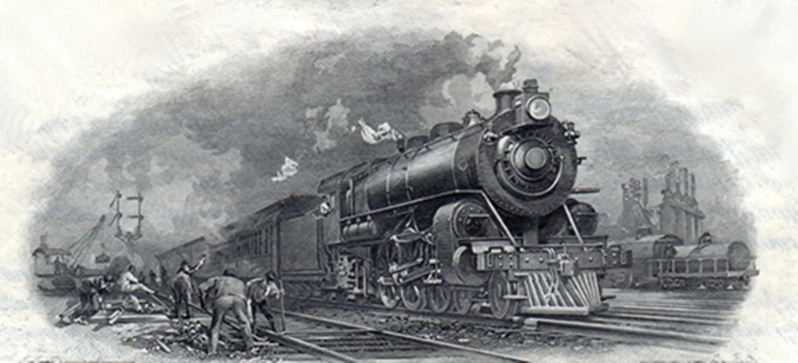
The Rail Part 2
Solid iron t-rail was developed by Robert Stevens in 1831, who was the President and Engineer of the Camden and Amboy railroad. This design has stood the test of time. A variation of the T-rail is still used today.
Robert received his experience, working with his father in the steamboat industry.
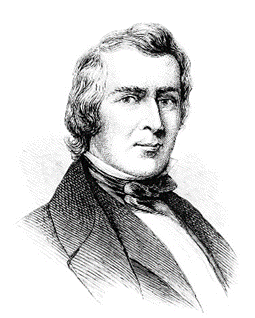
Popular Science Monthly Volume 12,
Public domain, via Wikimedia Commons
In 1831, Robert decided to go to England to have the solid rails manufactured, where he believed was the best rail. He could not find an American mill that could produce the quality product he wanted. It was not until 1846 that the firm of Cooper and Hewitt of Trenton produced them in America.
While on the voyage, Robert took a block of wood and whittled the model of the T-rail. A simple job of whittling a great ideal, never knowing it would revolutionize the railroad industry.
After Robert arrived in London, he placed the order for his solid rails and purchased the locomotive for his new fledging railroad. The figure below is a reproduced copy of the order Robert gave to the English mill. 1

A reproduced copy of Stevens order
Internet Archive Book Images, No restrictions, via Wikimedia Commons
In May 1832, his company received the first load of 500 rails. The rails were 15 feet long and weighed 36 pounds per yard. They were received in Philadelphia and upon reaching his company, were laid. Soon, the other railroads in the area and then elsewhere in America used the t-tail.
Stevens’ other inventions helped the T-rail to advance the railroad into the powerhouse of the transportation industry. The other inventions credited to him were, the “hook headed spike” and the “fishplate.” 1
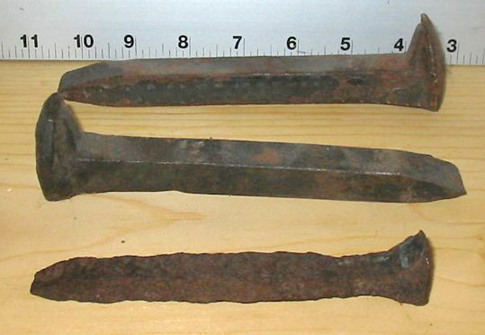
Two unused and one heavily corroded w:rail spikes.
Photo by Sean Lamb (User:Slambo), September 3, 2005
File is licensed under the Creative Commons
Attribution-Share Alike 2.0 Generic license.
The stone blocks to run the rails on were very expensive. So, Stevens laid down logs or wooden ties as they were called in America, on ballast or crushed rock to help facilitate drainage and ward off destabilization of the roadbed. 3
When ties were laid down on the ballast, they were aligned and leveled. Then they laid the rails on the wooden ties and fastened down with the hook headed spike. The wooden ties turned out to be a better choice and are also still used today with only a few slight modifications. 3
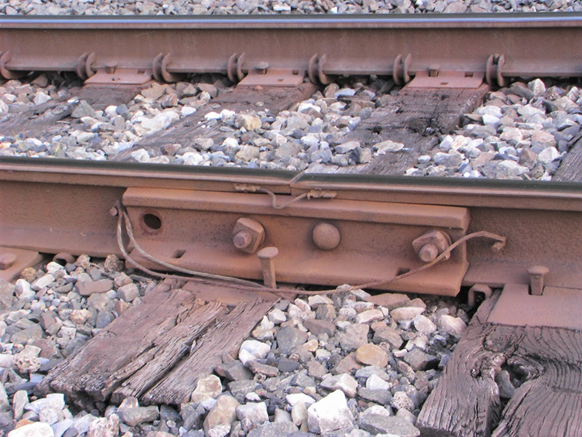
Shorter Pennsylvania Railroad fish plate
Velocicaptor, Public domain, via Wikimedia Commons
The rails were only 15 feet long. The rails were attached together with fish plates he had also invented.
With the rails being only 15 feet long, the connection would become uneven. When the train passes over the joints it would make a clickety sound. As goes the old saying “Clickety clack, clickety clack… the train goes around the track.”
An engineer mocked, that in America, “poverty is the mother of all invention.” He said this because Stevens had “Used wooden ties as a temporary substitute for the more expensive stone blocks. He finished off by saying, “They made better roads because they were too poor to make a bad one.” 1
Another Stevens invention was the” pilot” or what became known as the forward truck. It is attached to the front of the locomotive. Known also as a cattle catcher, whose job was to push the cattle off the tracks so the train would not derail. Instead, the cattle would become impaled on it, making it extremely hard to detach them. 3
Robert L. Stevens’ inventions left an indelible mark on the railroad’s history. His inventions can still be seen even today with a few variations. There are no life size monuments of his likeness erected. All one must do is look at the miles of track that peppers our countryside to see the most appropriate monument to one’s life and accomplishments.
Robert died never having been married. He also never patented any of his inventions.

Sandbox and delivery pipe
By The original uploader was Schorschi2 at German Wikipedia
- Own work (Original text: Eigene Fotografie), Public Domain, https://commons.wikimedia.org/w/index.php?curid=21209462
In 1836 a plaque of grasshoppers hit Pennsylvania. It was classified as a plaque of biblical proportions. When the locomotives would run over them the locomotive would lose traction. They had a crew to sweep in front of the train. Their efforts were in vain.
Someone had an epiphany. They used sand under the drive wheels to get enough traction to get the train moving. So, a sandbox was placed right over the drive wheels an spread over the rails. The picture above is a modern-day sandbox. 1
A lot of the ideals that were incorporated in 1830’s, although they have been improved on, are still in use today.
References:
1. The Great Railroad Revolution; The History of Trains in America by Christian Wolmar
2. The American Railway: It’s Construction, Development, Management, and Trains by Thomas Curtis Clarke
3. Encyclopedia Britannica at Railroad - Open Saloon, Double-Deck Cars, On-Train Dining Car, and Sleeping Cars | Britannica
History of the Railroads Article 7
The Rail Part 2
The following article are excerpts of a story as told by Mr. John Grosvenor by Frederick W. Kaul and L.A. Rollins for a Federal Writers Project. John tells his story of working for the Central Missouri Railroad.
With this article you will be able to see how tracks were laid, their upkeep and repair. Procedures and steps for the train’s safety after the flooding of the tracks. What can happen, such as washouts and destabilization of the roadbed and its seriousness.
Here is John’s story.
In 1880, John needed a job to feed his family. He had a homestead but could not make a living off it.
So, one afternoon, after having dinner at his father’s farm, four miles north of Logan, Kansas. Afterwards, John took off to find a badly needed job. Having walked eighteen miles, it was later in the afternoon when he found a job by finishing digging out a cellar which paid 50 cents in wages. Having brought with him seventy-five cents it gave him a stake to live off of until he found a job and got paid.
Before he went to bed that night, he had found a job with the newly completed Central Missouri Pacific Railroad for a dollar a day. He had to furnish his own accommodations, so he found a house to rent. He sent word to his wife that he would be home next Sunday to bring her back with him.
The work schedule was 10 hours a day, 6 days a week. After having worked that Saturday’s shift, he walked eighteen miles back home. They packed their stuff into a wagon and made their way back to the place he had rented and went to work first thing Monday morning.

Locomotive similar to what would have been used here
Pacific Railroad Locomotive Charles H. Peck 1869
Author unknown Public Domain through Wiki Commons
The work was hard. When they said ten hours of work, they expected ten big hours as John had classified working there.
John had acquired his farm through the Homestead Act of 1862. Through it, any person, if they had never borne arms against the United States, could claim up to 160 acres of land for a small filing fee. You had to maintain five years of continuous residence, build a home, and make improvements to the land.
He had to work on the railroad so he would have a stake to buy food while staying there.
So, John had worked for the railroad as long as he could and had to go back to his farm to maintain his eligibility. After spending the required time to hold on to his place, John went back to work on the railroad on April 1, 1882, for $1.10 a day.
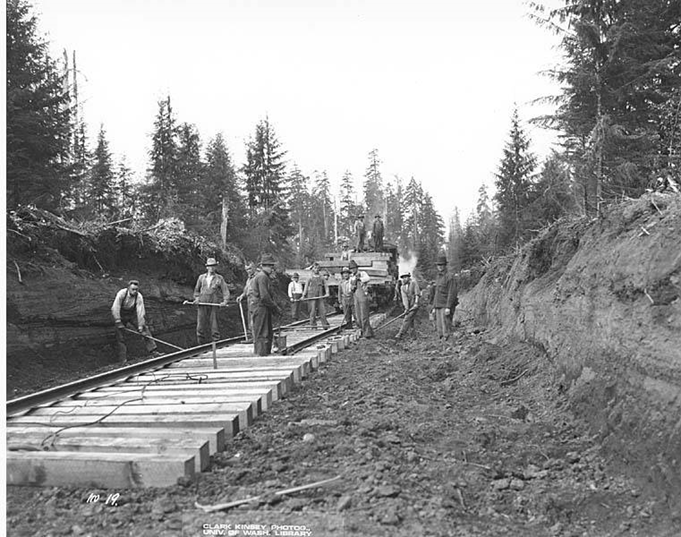
Work crew laying railroad rack Coats-Fordney Lumber Company, ca. 1921
Clark Kinsey, Public domain, via Wikimedia Commons
It turned out that 1882 was a very wet year. The section of track that John was assigned was prone to flooding. So much so was that when a big rain came, all hands on that section had to report to work that next morning. As the train came through, the section crews were in front of the train pushing the hand car. Of course, the train would follow just barely creeping along.
They were checking for soft spots in the ballast roadbed or washouts. Either one would cause the train to derail. When they found either, they would wave the flag, stopping the train so they could repair the track.
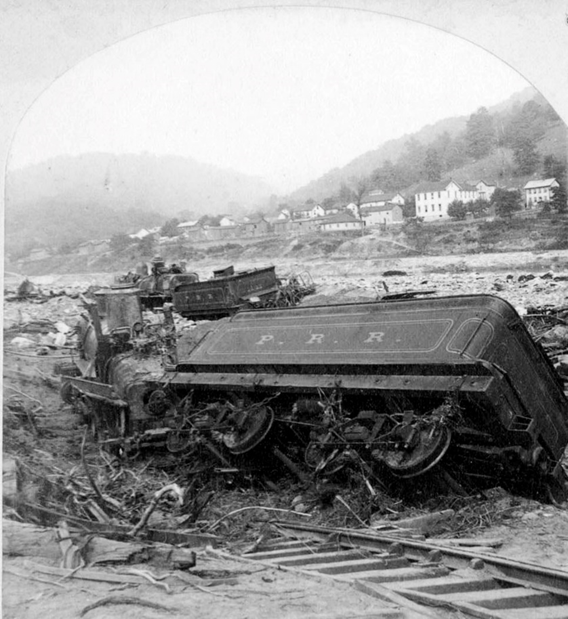
Shows several Pennsylvania Railroad engines overturned near railroad tracks
Library Company of Philadelphia, No restrictions, via Wikimedia Commons
No Known Restrictions Flickr Commons
The above picture shows the devastation of a flood in My 31, 1889 on the Pennsylvania Railroad. One would think that these heavy locomotives would stay put, but flooding takes anything in its path. Even locomotives weigh tons.
This would go on for miles, where there was one and a half feet of water covering the track.
They would keep going through the night, using lanterns to see. For three days and three nights they worked, finding over 3 miles of track that had been washed out.
They got help and repaired the washed-out tracks. It rained the entire time and in places it was between 1 1/2 feet to over a man's head deep.
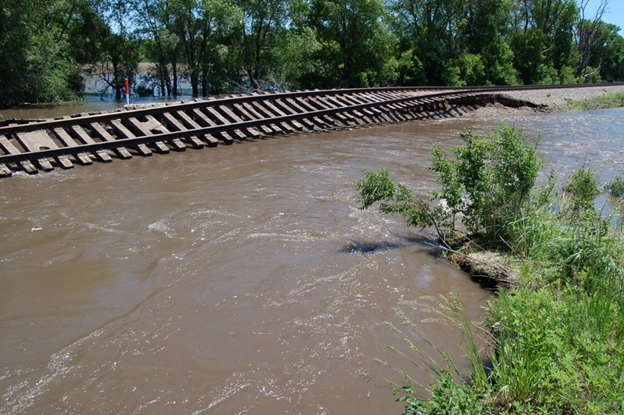
Railroad track near Plainfield, IA (photography: Don Becker, USGS)
PDRailroad track near Plainfield, IA (photography: Don Becker, USGS)
U.S. Geological Survey from Reston, VA, USA, CC0, via Wikimedia Commons
To repair the track, the rails had to be jacked up. They used timber, lumber, polls, iron along with anything else needed to fix the track. They would only use light trains and slowly get them through.
The men did not have any rain gear, so the men remained soaked the entire time. Also, food was in short supply. When they finally got home the men were so completely exhausted.
They received time and a half for the night work. With the rain continuing the entire month, they received almost double their wages for that month.
There was an ecological downside to all the rain. Ducks and frogs flooded the area, as well as the rain. John stated that millions of the animals came to the track and stayed. The noise was so deafening that some of the men had trouble with their hearing for weeks.
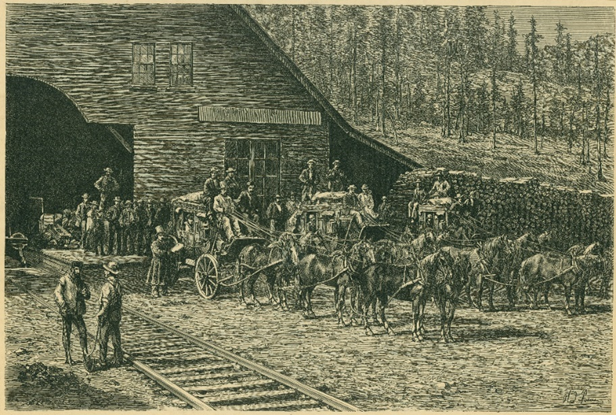
Stagecoach from Idaho on the Central Pacific Railroad
-
Bertrand, Public domain, via Wikimedia Commons
Reference:
-
Federal Writers Project by Frederick W. Kaul and L.A. Rollins Hasting, Nebraska, as told by Mr. John Grosvenor of hasting Nebraska “The New Railroad”
Article 8
The Building of a Railroad
The building of a railroad does not start with the laying of a single rail. It starts with a team of surveyors, engineers, topographers and axe man.
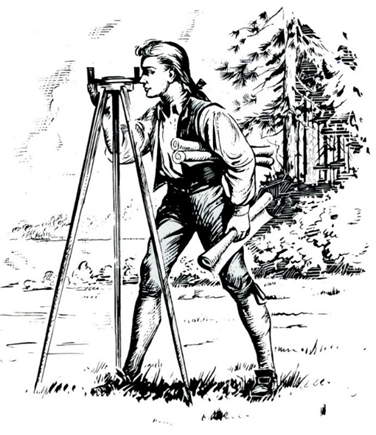
Youthful George Washington Surveying
National Park Service, U.S. Dept. of the Interior, not credited.,
Public domain, via Wikimedia Commons
Their job is to go out and to locate the best position for the proposed line. Finding the straightest, least number of streams, rivers, ravines to cross, along with the best route through the hills and mountains.
The route was very important. The topography, or detailed description or representation on a map of the natural and artificial features of the area, 1 is very important. If the route has too many hills, valleys, gorges or rivers, it will not make sense to route the railroad this way. There would be too much infrastructure needed such as, bridges, trestles, culverts and switch backing. These cost money and after they are built, maintenance and repair would also play a major factor in operating expenses. All this would not make it feasible monetarily to build the railroad on this route.
So, a civil engineer, hopefully a good one, along with a crew would layout a route that financially is the most likely cost efficient to operate.
The full survey party consisted of:
- Civil engineer
- Chief of Party
- Front flagman
- Axe men
- Transit man
- Chainman
- Flagman
- Leveler
- Rodman
- Rear Axman
The civil engineer had the responsibility of plotting out a route that was the shortest, cheapest and straightest. The route that avoided tunneling, cutting through mountains and sharp curves. The picture below shows an example of cutting through a mountain to keep the gradient less than 2% rise.
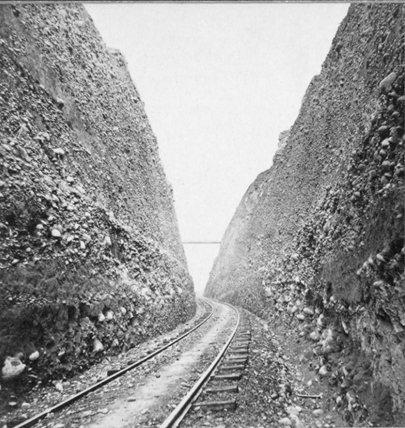
Cutting Through A Mountain
New York Public Library, Public domain, via Wikimedia Commons
This is very important, for wear and tear upon the locomotive and its efficiency.
To get a better perspective of the layout of the land, the engineer would at times be lowered over the face of a mountain in a boson’s chair to get a clear view of the large section of the route. It helps to see the overall lay of the land. Helping in making the right decision and just how they would lay out the road.
The surveyors came first. A transit man who was responsible for operating the transit, which is an instrument for measuring angles and distances. He was aided with the help of the chainman and forward flagman. The transit men recorded the data, that the topographer would use to draw the maps that were so vital in the map making process.
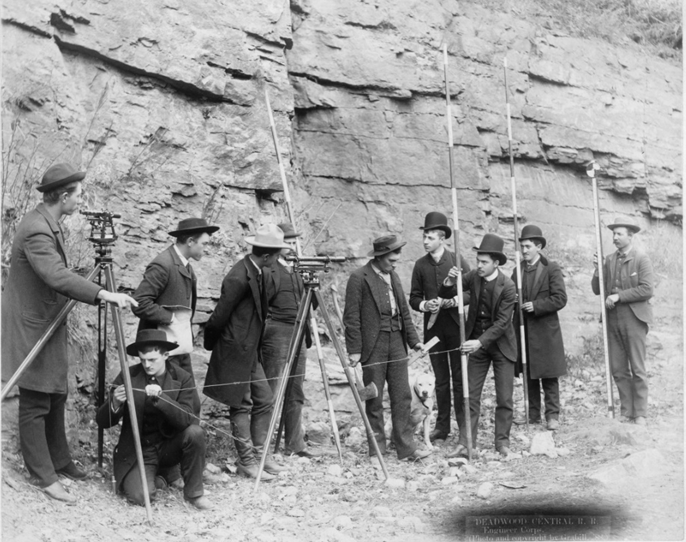
Deadwood Central R.R. Engineer Corps
John C. H. Grabill, Public domain, via Wikimedia Commons
The front flagman would take his corps of axmen to clear the route of trees and brushes. This would allow the transit man to measure out the road clearer. Then along with the chainman he would take his measurements.
The axe-man, after clearing the path would makes the wooden stakes for the transit man (surveyor). The Surveyor would use these stakes to layout the path for the leveler to take his measurements. Also, for the construction crew who followed, for the building of the roadbed and the laying of track.
Chief of party: this position organizes and coordinates the work of the survey party to perform the design, surveys, construction, staking and is the overall supervisor. He also referees conflicts in personnel matters and ensures the camp is set up and running smoothly.
The topographer assists the chief of the party when needed. He also takes the recorded measurements from the transit man and the leveler, entering them into his journal on the topography of the landscape of the country. Topography is the study of the forms and features of the landscape. He sketches the contour of the hills and the direction and size of the rivers.
His detailed maps feature the contour of the land which includes the mountains, hills, creeks, elevation changes, valleys and lakes.
All the jobs on the survey crew are important, but the topographer’s map making ability extremely helps corporate see the layout of the land where the railroads were being built.
The cost and quality of the line is directly proportional to the quality of the survey team. It is their responsibility to properly locate the most level course possible. This saves fuel, wear and tear on the locomotive, cars and infrastructure.
In a new uninhabited land, the straight line, that's flat is the cheapest line possible. It would also have the least graduates as possible or a rise in elevation of the track. The locomotive would use less fuel and water, saving operating expenses and time.
The train of the 19th century could not transit up an incline of little more than 2%. So, sharp curves had to be avoided. Along with staying away from hills and ridges to avoid having cutting through them, to keep the tracks as level and straight as possible.
Ravines were either filled or bridges would have to be constructed. Avoiding major lakes and rivers, that would require the building of bridges, trestles, culverts and revenues. When it came to crossing rivers, they looked for a place to cross with the least amount of difficulty.
Snowstorms were also observed with great concern, when building the transcontinental railroad, snow drifts were of great concern. In the Rocky Mountains the snowdrifts could reach up to 20 feet. They would cover the road and prevent trains from passing. Snow sheds were constructed between tunnels and areas where the snow drifts where drifts were known to accumulate.
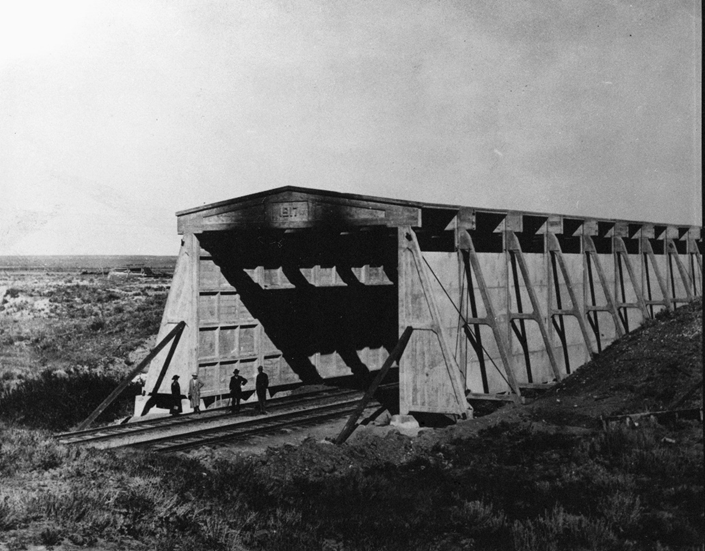
Concrete Snowshed circ. 1917
Scan by NYPL, Public domain, via Wikimedia Commons
The biggest reason a railroad ran into financial difficulties was poor preplanning. That is not taking the time to survey the route properly, staking out the route and then having the construction crew follow it.
In his book The American Railway: Development, Management and Trains, Thomas Curtis Clark put it this way. “It must be remembered that a cheaply constructed line can be rebuilt, but a badly located line, nothing can be done except to abandon it entirely.” Not doing the job properly can be costly.
It is extremely important to locate the line near streams and rivers. Locomotives needed large amounts of water to operate. Also, people and livestock required the same amount.
A level roadbed is very important to provide a stable ride for the train and passengers and for their safety. If the roadbed is unstable, this could cause the train to derail. Also, just for a smooth ride.
If laid out correctly, towns would spring up after the completion of the road, with the railroad choosing where the depots would be placed. They were usually near a good supply of water for the thirsty locomotives. Families and livestock also needed the same amount of water to survive.
Article 10
The Building of the Railroad
Laying Track Part 1
The railroad was one of the single greatest developments of the modern age. You might say the highway was linking cities, towns and states. Maybe space travel was a greater development? I might say the invention of Pepsi was, it has been my favorite choice since I bought my first one at Ernest Ruth’s store in Knob Lick in 1962.
Building any railroad system was an arduous task. After the surveying crew had laid out the route to take, the tie gang, played a vital role in its construction.
Before we get to much further into this article, we need to tell the story of how we got the wooden tie. Yes, there is a story behind the wooden tie. There always is a story behind everything.
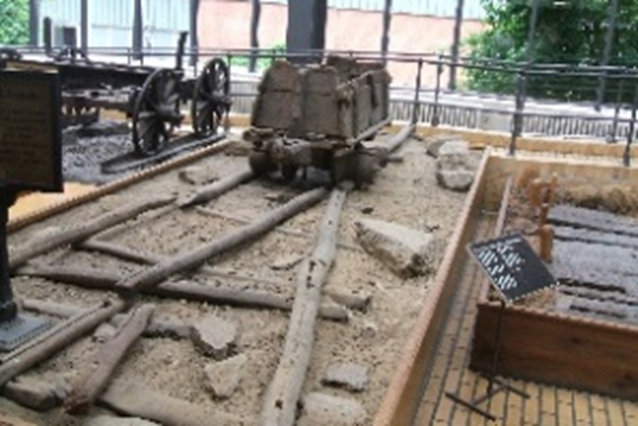
Afterbrunel, Public domain, via Wikimedia Commons
The above picture is of a section of track from the 16th century gold mine in Transylvania. The wooden wheels, which had a pronounced flange, guided the wagon along. The rails were made of crude logs, made out of small trees, placed atop cross ties.1 Today you would almost laugh at it, but back in the day it was the “Bees Knees.” Wrong era, but you get the drift.
In the last article we saw how the steel rail was born. It has not always been a fact that the
steel rails sat upon wooden cross ties as we know it. In the birth of the modern-day railroad,
stone blocks were used to place the cross ties to support the steel rails.
Robert Stevens, the president and chief engineer of the Camden and Amboy Railroad of New Jersey, were laying track and ran out of stones upon which to lay the rails on. Desperation is a mother of invention. So, needing an alternative material to use, Stevens came up with ties hewn from logs. The forest close to where they were laying track had an abundant supply of trees which they could use for the purpose needed.
After they had laid the track, then riding the rails where wooden ties were used, Stevens noticed that the wooden cross ties offered a smoother ride.
The wooden ties were called sleepers. They secured the track firmly and helped provide a
stable base. Thus, the smoother ride.
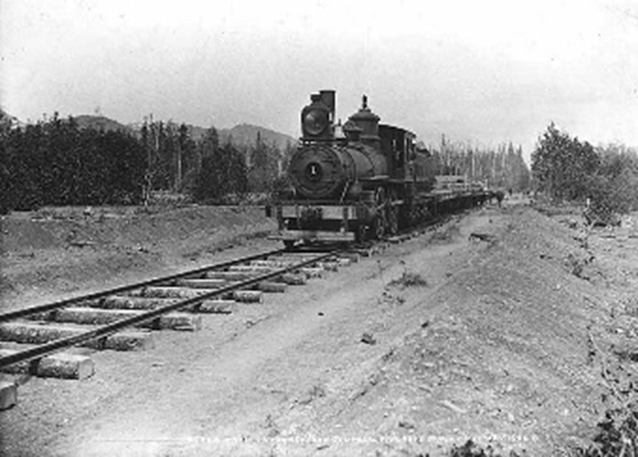
Tails On Rough Cut Logs, No Ballast
University of Washington, Public domain, via Wikimedia Commons
The ties primary material of choice is hardwood. Oak is the number one sought after material. It offers the strength needed along with longevity. 2 Another reason hardwood was ideal was if it could firmly hold spikes in place.
The railroad relied on getting ties to keep construction progressing. Missouri was the ideal place to contract for them. The hardwoods needed were indigenous to the area, plus their abundance made it the ideal place.
In the 1800’s, as the railroad pushed westward, a continuous supply of ties was needed.
Missouri’s forests were strategically located and were brimming with the sought-after hardwood, such as oak.
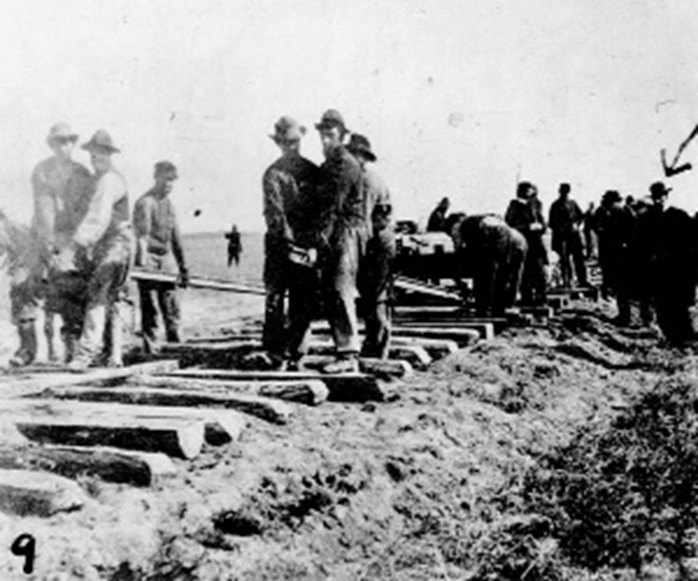
Men Laying Rails On Roughly Cut Rails
Public Domain, Wiki Commons
Men called Tie Hackers would search in the forest, looking for a tree that would yield ties that would pass inspection.
Their tools consisted of a two-man crosscut saw, a double bit axe, a broad axe, and a measuring device called a tree scantling to ensure the correct length. Then they had a mule for getting the logs to the river where they would tie them together for transport down river. Then a small quantity of coal oil for removing resin and gum from their saw blades.
They would enter the forest for a full day's work. Packing a lard bucket filled with a mason jar containing drinking water and covered in toe sack to keep the water cooled. Plus, it carried their lunch of beans, fried pork, cornbread, and an onion.
For a full day's work, a good tie hacker could produce 10 to 15 ties daily.
The railroads were specific in the dimensions. Also, if there was even a knothole, this would cause the tie to fail inspection and be worthless.
Some hackers found a way around this. They would cut out the knot and insert a dowel of the same material in the hole. They would use a broad axe to scrape it was smooth and then rub some dirt on the area to help hide their deception.
The ties would be cut to 8 to 10 inches square and 8 to 10 feet in length, depending on their application.
In the 1930s, the tie hacks would receive 50 cents a tie. They would receive on average $5 to $6 per day for a standard 12-hour work shift. The landowners seem to have gotten the short end of the deal. In the early days the landowner received no monetary compensation. It wasn't until the mid-1930’s, when the price of ties increased, that the landowner received about 25 cents per tie.
Again, the number of ties that were required were ever increasing. In 1900, 110 million ties were needed annually. These were untreated ties which had a life expectancy of four to six years.
Creosote, a coal tar, was started to be used as a preservative. This increased the ties life expectancy to be about 30 years. 3
Meanwhile, back at the track. Tie gangs laid the sleepers (ties) and steel rails on the roadbed. To fully capture the true job of the tie gang, here is a step-by-step process they followed. Sidetracks were filled with supply trains. Each would be carrying tons of steel rail. Also loaded on the cars with thousands of cut ties.

Supply Train Loaded With Rails
No Known restrictions Wikki Commons
Horse and wagon brought the rails, ties, spikes, and fish plates. Men would quickly unload the wagons and send them back for more.
The ties would be placed upon the roadbed laid 19 to 19 ½ inched apart or 3,250 wooden ties per mile.
Five men on both sides would seize the rail with their tongs and start forward. They came at a run placing them on the ties on the roadbed. Then came a demand of “Down.” You would hear the command shouted about every 30 seconds.
The gauger would set his measuring rod, which is exactly 4 feet 8 inches and 1/2 inches, the
standard gauge and measure the correct width between the rails. After the rail was checked the chief spiker and his men would make their hammers sing out. Two rails every 30 seconds were laid down, and four rails a minute. Listening to the steady beat of the sledgehammer.
There would be thirty men driving spikes, three strokes per spike, ten spikes per rail. Four hundred rails per mile. 3
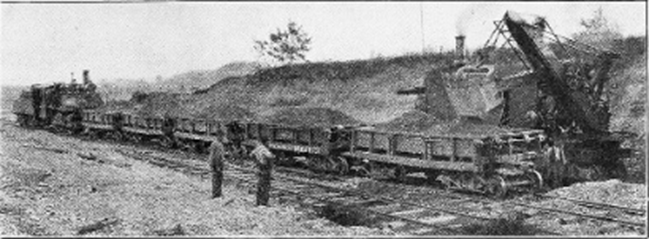
Scooping Ballast for Transport
Public Domain, Wiki Commons
Ballast is the last item applied and another vital part of the roadbed. It not only keeps moisture drained away to keep the roadbed solid but is a support base for the ties and rails. It gives strength and rigidity to hold up to the stringent force exerted by the passing train. It also makes it have a flexibility to help absorb the energy induced when the train passes over it.
Over time, it has been found that limestone and quartz make the best ballast. It is a hard stone, and it will lock together, strengthening the base even more. 5
The ballast needs to be packed down and at least the depth should be up even to the height of the tie. The ballast also needs to be extended out 14 inches on either side of the track sloping downward for drainage.
If the system that was just described had been constructed properly, there would be no standing water on the track or in the ditches running parallel to the track. There also would not be any foliage growing in the draining ditch.
There is maintenance required. The ballast would require washing to allow the water to run away from the roadbed. Plus, there would be times when the sleepers would need replacement.
Most people can identify some parts of the railroad. The spike is the most recognizable. The spike is so simple, that most people can draw it. Even if you don't possess the drawer’s gene. I don't know if there is one, but if there is, I don't possess it. So, I’ll show you a picture. Although simple looking, it took a while to perfect. In the beginning of the modern railroad, there was nothing to compare it to.
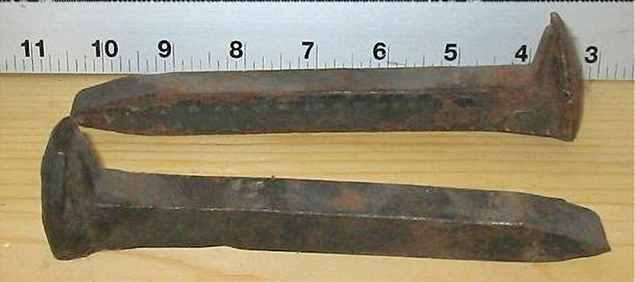
Railroad Spike
Creative Commons Attributions Share Alike 2.0
Photo by Sean Adams
Ref:
-
Lee, Charles (1943). The Evolution of Railways (2 ed.). London: The Railway Gazette. pp. 18–19. OCLC1591369
-
Referencing American Railway Engineer Association
3. Sleepers Through Time by Lynn Barnickol; October 2, 1996 From Missouri Conservationist: Oct 1
-
Nothing Like it in the World, The Men Who Built the Transcontinental Railroad 1863 to 1869, by Stephen E Embrose
-
Brian Solomon’s book Railway Maintenance, and Men and Machines That Keep The Railroads Running.